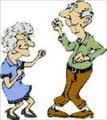Dance The Years Away
Seniors who participate in dance-based therapy are benefiting from a win-win-win situation: they are having a great time, improving their balance, gait, and overall functioning, and reducing their risk of falls, fractures, and immobility. Dancing is good medicine for seniors, according to two new studies and several previous ones.
The new most recent studies, conducted by researchers at the University of Missouri, involved use of a dance program called The Lebed Method (TLM), which involves a combination of low-impact dance steps set to music. The dance sessions for seniors were led by certified TLM instructors and modified to accommodate the needs of the individuals who participated.
In one study, a series of 18 dance sessions were offered over a two-month period at an independent-living community. Jean Krampe, RN, and one of the study’s authors, noted that the seniors enjoyed the dance sessions and wanted the program to continue. “We found that dance therapy can increase their walking speed and balance, which are two major risk factors for falling.”
In an earlier study conducted by Krampe and her colleagues, eleven seniors participated in a six-week pilot study. More than half of the seniors reported improvements in their balance and gait after the sessions.
Dancing is good for seniors for reasons beyond better balance and gait. A study from Albert Einstein College of Medicine studied 469 people age 75 and older and found that ballroom dancing was associated with a lowered risk of dementia. The researchers believe that the mental challenge of following complex dance steps and moving in time with the rhythm of the music are responsible.
In a review conducted at AUT University in New Zealand in 2009, researchers evaluated 18 studies that involved dancing as a mode of physical activity for older adults. The researchers found evidence that older adults can significantly improve their aerobic ability, lower body muscle endurance, strength, balance, agility, and gait through dancing.
In yet another study, researchers studied the effect of a traditional dance program on balance control in elderly adults. Twenty-six older adults living in the community were randomly assigned to a supervised Greek traditional dance class for 10 weeks (1 hour, two sessions per week) or a control group. Adults who participated in the dance class showed a significant increase in the range of trunk rotation, which supports the use of traditional dance to improve balance control in the elderly.
These studies are only a few examples of the growing evidence that dancing is good medicine for seniors. Improvement in balance, gait, cognitive abilities, and weight control, as well as better mood because of the socializing aspect of dancing are all good reasons for seniors to take to the dance floor.
SOURCES:
Keogh JW et al. Journal of Aging and Physical Activity 2009 Oct; 17(4): 479-500
Sofianidis G et al. Journal of Aging and Physical Activity 2009 Apr; 17(2): 167-80
University of Missouri
Verghese J et al. New England Journal of Medicine 2003 Jun 19; 348(25): 2508-16

